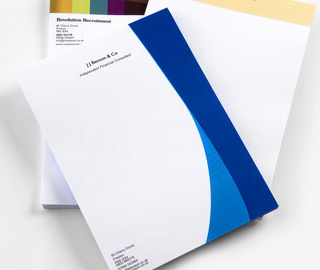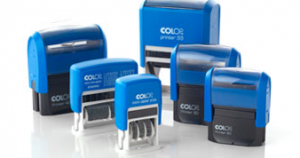If you’re the owner of a small company, you’ll be well used to communicating with your clients, customers, and even your employees through the postal system. Although we’re bang in the middle of the digital age, sending paper mail is still a crucial part of running any business – not everyone has an email address, after all!
You might have considered investing in custom letterhead printing for your small business. But is it really worth the price, and how will it benefit your company? Let’s find out.
What are Custom Letterheads?
The letterhead refers to the header portion of a letter that typically includes a business’s logo, company name, address, and other identifying information. Its main function is to provide all the necessary information to the letter’s recipient (i.e. how to get in touch with the company).
But having a custom letterhead also helps your business appear more professional. It serves as the basic introduction to your business – your overall style and aesthetic, what your company stands for, who your customers are, and more. In fact, many of your clients will form their first impression of your business through your letterhead.
Creating a custom letterhead for your business is simple and straightforward with a site such as 123Print. Choose from thousands of pre-designed templates or use our editor to create your own letterhead design from scratch. You can even create a letterhead to match your business cards or other branded stationery.
What Goes Into a Custom Letterhead?
There are many different aspects to designing a custom letterhead, each of which plays a role in its final look and feel.
Graphics and Logo
The first major aspect is choosing which graphics to use on the letterhead. The most important graphic is your company’s logo, but other graphics can also be included, such as borders or stylistic elements that add a pop of colour.
The combination of graphics used will really be the face of the company. Choosing where to put the logo, how large it should be, and how it works together with other graphics on the page will all impact the overall look and feel of the letterhead.
Colour
Along with the graphics, colour also plays a major role. Consistency of colour-use across the company is crucial. Knowing and using the exact shade is necessary for this. Colour, along with the graphics, will speak volumes about the kind of company the letterhead belongs to and is one of a business’s best opportunities to give the right impression of their brand. Traditional blues, blacks, and browns speak to a more formal, professional business, while reds, oranges, yellows, and purples speak more to fun and fresh designs.
Shades of blue can be used to create a calm, relaxed feel, while vibrant shades of red and pink give an impression of excitement and vigour.
The colour scheme you choose for your letterhead is up to you, but ensure it ties in nicely with your logo and your business cards.
Font
Next, the font choice is also a big company branding decision. Serif fonts like Times New Roman tend to be more traditional, and project the image of a professional, established business. Sans serif fonts like Arial are more popular nowadays and are generally fairly neutral. They’ll give the impression of a modern, up-and-coming company, particularly associated with youth.
You’ll also want to think about the font size of the letterhead in relation to the main body of the letter. Sticking with a more traditional and easy-to-read font is best in most cases. Fancier fonts, such as script, can be left for the logo design.
Alignment
The alignment refers to the placement of the information in the header, which must be coordinated with the graphics. Traditional alignment is left-aligned but that is not necessarily standard in letterhead design today. Different designs will work better with different alignments, and different brands might want to experiment with different alignments to see what impact they have on their customer base.
Paper Stock
Choosing the right grade and style of paper can also help elevate your brand and your company’s reputation. Heavier stock is more expensive, but can feel much better. Similarly, having raised lettering can help create an impression of high quality and professionalism.
Should a Small Business Invest in Custom Letterheads?
In short: yes! Custom Letterheads are a great investment for any business, from the smallest of start-ups to large, multi-national corporations. A custom letterhead will especially help to bring legitimacy to a small, up-and-coming business that’s looking to grow its customer base.
Getting your brand story out there with a well-designed logo placed onto your company letterhead, business cards, and other stationery can really boost the success of your small business in the professional sphere. Here’s how:
Tying Together Your Brand Image
Establishing your brand across a variety of business tools is essential to building trust and recognition within your customer base. Showing that you have a coherent brand vision across your business materials will also give your customers something to remember you by, better painting the image of your brand in their heads. Getting customized letterhead is one of the best ways to make that step forward in brand coherence. Clients and partners alike will better appreciate and understand the brand while also taking the company more seriously (reducing the chance that they’ll visit a competitor next time they’re in the market for your goods and services).
Selling the Product
Custom letterheads can also act as a kind of salesperson for your business. Many customers are interested in being sold an aesthetic and a way of life. The letterhead, along with the logo, colours, and design choices that come along with it, can provide your customers a way to connect with the brand that makes them want to integrate it into their everyday life.
Think about the Apple, Tiffany’s, or Starbucks customer – these companies create an amazing, branded customer experience that makes their clients want to keep and show off their products. In part, this is due to great design choices for getting recognition for their products.
You’ll only be able to get that level of specific, branded experience with a custom letterhead design.
Projecting Professionalism
A custom letterhead immediately projects an air of legitimacy and professionalism. Even if you’ve just started this business out of your living room or garage, you’ll be showing commitment to the brand through the effort to present a specific, coherent image of yourself as a company.
The formal character of a custom letterhead will also increase your perceived competency as a business for those hesitant about working with a less-established organisation. Company size may not matter as much if your correspondence with partners and customers comes off as professional and legitimate.
Offering a Personal Customer Experience
Finally, customers are looking for that personal connection these days from the small businesses that they choose to patronise. One of the greatest charms you have as a small business is your personal, unique brand.
If your business letterhead, cards, and promotional products use run-of-the-mill, unedited templates (or if you don’t have a letterhead at all), customers will not be able to distinguish what makes you different from the big brands. You’ve got to embrace your niche and what makes you special in order to attract customers who want a more personalized, unique experience.
Where to Order Professionally Printed Custom Letterheads
Today, with the rise of so many small companies selling products locally and online, the power of professional and recognisable branding cannot be overestimated. People want to both trust and connect with the small businesses they support, and investing in customised letterheads is of the simplest and most affordable ways you can achieve this relationship with your clients.
Head to 123Print to browse our extensive range of over 2,000 custom letterhead templates. When you’ve found a design that speaks to you, simply to go our easy-to-use template editor to fully customise your letterhead. Upload your business’s logo with the click of a button, and tailor the font to your business’s tone and style.
We aim to dispatch all orders within 2 working days. And if you’re not satisfied, you can send your stationery back for a full no-quibble refund. Start designing your custom letterheads today – and why not invest in some matching business cards while you’re there?


